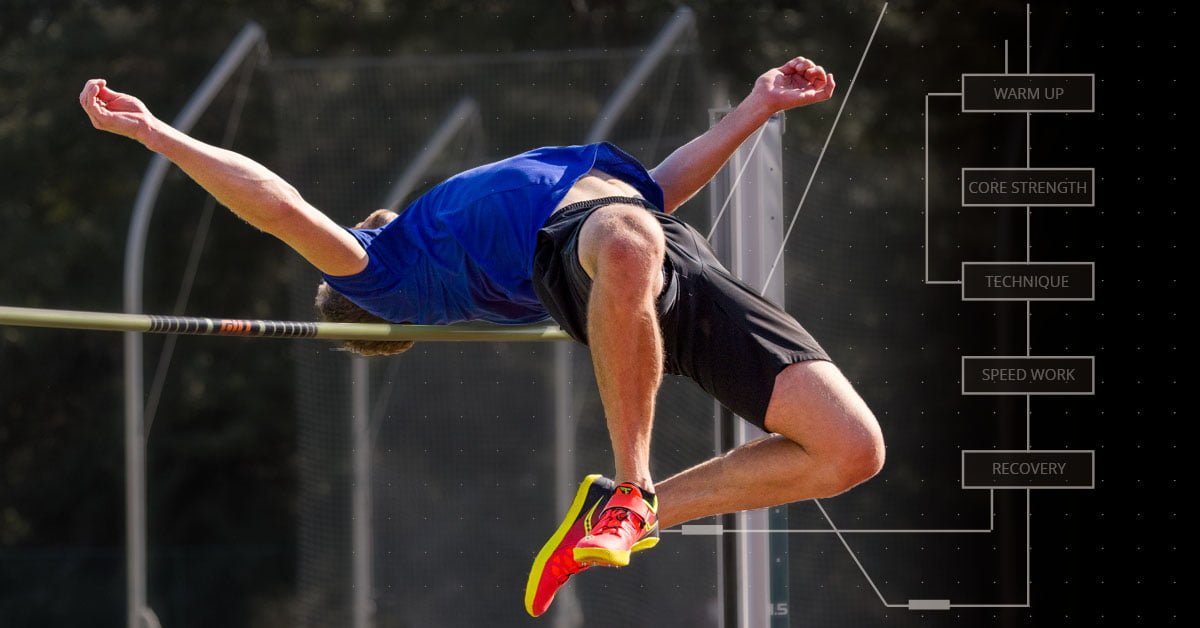
Sprinters, hurdlers, and jumpers know that a proper track and field warm up before practice is non-negotiable. If you skip this critical part of training, you'll be slower, stiffer, and more injury prone.
But you may be committing another warm up mistake that has almost as much performance-diminishing potential.
Warming up the wrong way may be just as bad as not warming up at all. Research has demonstrated that some of the more entrenched elements of the common warm up are not only a waste of time but actually harmful.
If you've been doing the same warm up moves you learned in middle school, it's time to move on.
This guide will teach you the three most common track and field warm up mistakes and how to avoid them.
You'll also learn how to properly prepare the body and mind for hurdles, jumps, and sprints training.
A proper warm up sets the stage for everything that follows in practice or competition. This is especially true for sprinters, hurdlers, and jumpers because of the extreme loads exerted on the muscles.
If your training preparation is lacking, your sprinting, hurdling, and jumping results will be too.
We're sharing the best warm up strategies and routines deployed by some of the country's most effective track & field coaches.
You'll learn the three-step warm up drills and structure proven to improve performance and reduce injuries step-by-step.
Whether you're warming up for the 100M, 200M, or 400M sprints or hurdles, or the high jump, long jump, or triple jump, this guide will prepare you for a productive training session.
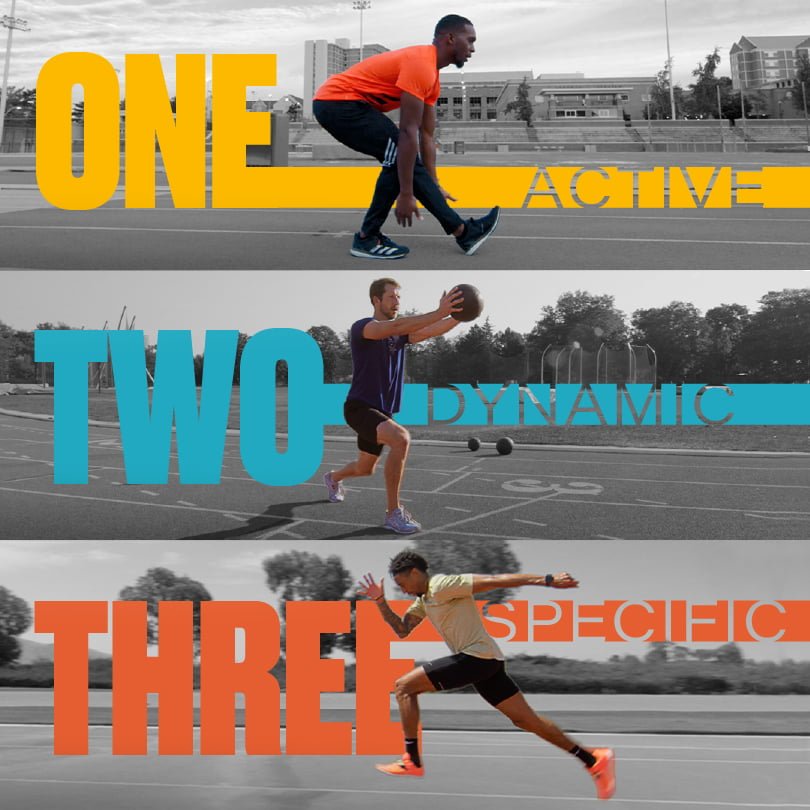
The Wrong Way to Warm Up
Starting with a jog around the track.
Starting your workout with a haphazard shuffle around the track will have you jogging into a hazard.
While a light jog will raise your body temperature, it isn't the best way to begin your track and field warm up.
Most athletes, from grade school to elite collegiate level, have likely spent the day sitting. Your muscles have remained in a shortened position with little mobility all day. Your brain, muscles, and joints are not ready for a light jog.
A quick jog isn't going to loosen and activate those muscles and joints enough to avoid injury.
More importantly, you will be practicing movement patterns that promote poor running technique. This is the wrong neuromuscular message to send to your brain.
If you go straight into a slow run, you will take hundreds of poorly performed steps that will likely carry into your practice form.
Instead, walk and do some light dynamic stretching before you begin jogging.
Stretching is warming up.
Remember doing static stretches in gym class where you held a series of positions for a count of 20 or 30?
That wasn't just a waste of time; it may have actually hindered your performance.
Studies have shown that traditional static track and field warm up stretches before a workout can decrease strength and power and negatively influence explosive force and jumping performance.
A neuromuscular inhibitory response to the long, static stretch causes the stretched muscle to be less responsive and weaker for up to 30 minutes. This is not how you want to start your training.
Rather than simply stretching, the new focus for track and field warm up exercises is on dynamic movements, muscle activation, and nervous system readiness.
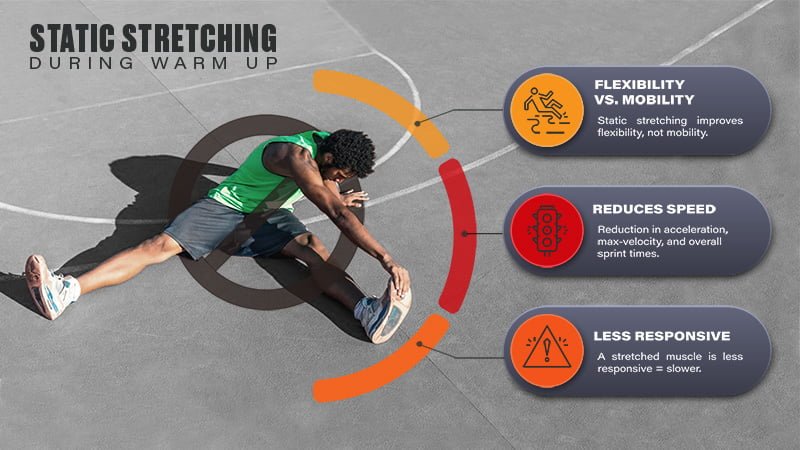
The actual workout starts after the warm-up.
The track and field warm up is the foundation of the workout. It is not a time to save energy.
It's a time to expend energy and get the muscles, joints, and mind ready to perform.
Not only are you preparing the body for the dynamic range of movements required during sprinting or jumping, but you are also waking up the vital communication between the brain and muscles.
You need to stimulate the brain to activate more muscle fibers and improve timing so that the movements involved in jumping and sprinting mechanics become more coordinated and efficient.
If you simply "go through the motions" and save your energy and focus for the "real" training, you not only run the risk of injury, you are diminishing your performance potential.
A focused, well-executed dynamic warm up is proven to improve explosiveness. That means higher, farther jumps and faster sprints.
In the video below Olympian Jeremy Dodson shares valuable insight on how to approach your track and field warm up.
The Right Way to Warm Up
The most effective track and field warm up includes:
Dynamic Movements: These are stretches and movements that loosen and activate your muscles and improve your range of motion.
Mobility Exercises: These drills improve your joint mobility and prepare your body for the demands of your training.
Activation Exercises: These exercises engage and activate specific muscle groups used in sprinting and jumping. This is especially critical on days that include high intensity training like block starts or max velocity work.
If you want to prevent injury, protect your joints, and get the most out of your practice, don't waste your warm up.
A complete warm up should take 35-50 minutes.
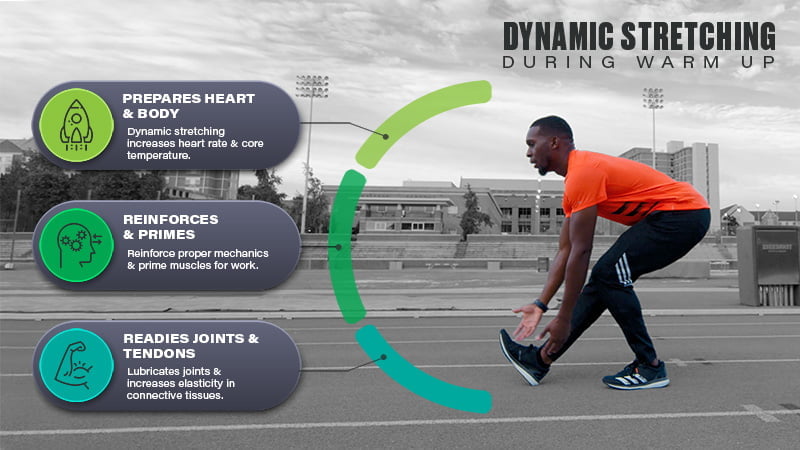
The 3 Essential Steps of a Track and Field Warm Up
Step 1 - Active Warm Up
Start with total body movements at a low intensity and gradually increase effort and event specificity. Begin with controlled, easier exercises that focus on flexibility and proper mechanics.
Step 2 - Dynamic Warm Up
As you warm up, increase the intensity with more dynamic movements that improve your range of motion and stimulate the nervous system. A gradual increase in tissue temperature, elasticity, nervous system stimulation, and muscle recruitment decreases the risk of injury.
Step 3 - Event Specific Warm Up
Once you are sufficiently warmed up, it's time to incorporate event-specific exercises to engage and activate the muscles, joints, and neuromuscular pathways most important to your event.
This final phase should include more complex technical elements related to the event and should connect your track and field warm up and the main training session.
If an athlete is using a mental practice routine (which every track and field athlete should) it would come directly after this step.
Step 1: Active Track and Field Warm Up Drills
Drill #1 - Arm Swings
Why it works: Arm swings engage the upper body muscles, stretching the shoulders, arms, chest, and upper back.
How to do Arm Swings:
- Walk forward for 20-30 meters while swinging each arm around in a large circle from back to front.
- Then reverse the movement and walk backward for 20-30 meters while swinging each arm around in a large circle from front to back.
Drill #2 - Walking Quad Stretch
Why it works: The walking quad stretch increases range of motion and activates the quad muscles.
How to do the Walking Quad Stretch:
- As you walk forward, bend one knee and grab you foot behind you with the same hand.
- At the same time, rise up onto the toes of your other foot and reach the same hand high overhead.
- Pause and release while stepping forward and repeating with opposite legs.
Drill #3 - Hamstring Sweeps
Why it works: The hamstrings are the most commonly injured leg muscle. This warm-up drill will activate the hamstrings and get the nerves firing.
How to do Hamstring Sweeps:
- Start by standing with your arms at your sides and your palms facing forward.
- Place one foot ahead of you with your heel on the ground, your leg straight, and your foot flexed.
- At the same time, lean forward reaching your hands towards your ankle in an upward sweeping motion.
- Stand up in a fluid motion and repeat with other leg.
Drill #4 - Lateral Leg Swings
Why it works: Lateral leg swings extend the range of motion of your hips and gets the muscles, tendons, and joints ready for power.
How to do Lateral Leg Swings:
- Standing while using something for support (wall, fence, etc.) swing one leg from right to left in front of you.
- Do this for multiple reps and then alternate legs.
Drill #5 - Alternating Knee Drops
Why it works: Alternating knee drops warm up the hips and lower back to decrease hip rotation tightness.
How to do Alternating Knee Drops:
- Sit with your knees bent in the same direction, resting on the ground while using your hands to support yourself behind you.
- While attempting to keep your feet touching the ground, rotate your knees to bend in the opposite direction.
- Repeat switching sides for multiple reps.
Drill #6 - Rocking Adductor Stretch
Why it works: The rocking adductor stretch improves hip mobility and external rotation while activating the muscles on the inside of the leg (adductors).
How to do the Rocking Adductor Stretch:
- Start on your hands and knees with one leg straight out to the side.
- Make sure your foot on your bent knee is slightly inside of your knee.
- While keeping your spine in a neutral position, rock back slowly until you feel a stretch along the groin and inner thigh.
- Rock forward to your starting position. Repeat and switch sides.

Step 2: Dynamic Track and Field Warm Up Drills
Drill #1 - A Skips
Why it works: This common drill reinforces good posture and efficient foot contact.
How to do A Skips:
- To perform an A-skip, lift one knee up to waist height and move forward while lifting your other toe in a skip.
- Drop your foot and drive your other knee up and forward to skip with the second foot.
- Continue this skip alternating legs.
- Focus on striking the ground with your mid or forefoot while swinging opposite arms.
- For a detailed breakdown on the A Skip, check out our sprinting drills for beginners guide.
Drill #2 - B Skips
Why it works: The B-skip is a progression following the A-skip using the same cadence. It reinforces knee drive and “gripping” the track with the foot.
How to do B Skips:
- Start by doing an A-skip but instead of pulling the foot back down immediately after lifting it, extend the leg out in a kick and then pull it forward and down to land on the ball of the foot.
- Continue moving forward while alternating legs and arms.
- Focus on striking the ground directly below your center of mass and maintaining proper posture.
Drill #4 - Knee Buffs
Why it works: Knee buffs improve knee mobility, warms up the joints, and activates the muscles and tendons surrounding the knee.
How to do Knee Buffs:
- Stand on one foot with other leg flexed and hovering off the ground in front of you.
- Lower slightly in a mini-pistol squat movement and return to standing.
- Repeat switching sides for multiple reps.
Drill #4 - Straight Leg Bound
Why it works: This is a plyometric exercise that activates the glutes and hamstrings and improves strength and power. It’s a great way to work the non-dominant side of the body.
How to do Straight Leg Bounds:
- Start by lifting one leg off the ground and extending it out in front of you as far as you can.
- Push off the ground with the other leg and hop forward, landing on the same foot that you started on.
- Immediately hop forward again, landing on the other foot.
- Continue alternating legs as you bound forward.
- Focus on keeping your legs straight as you bound, as this more effectively engages the muscles in your legs and hips.
- Aim to land softly on the balls of your feet to reduce the impact on your joints.
Drill #5 - Lateral Skips
Why it works: This exercise gets you out of the sagittal plane and works your hip stabilizers.
How to do Lateral Skips:
- Start by skipping in place to get into the right rhythm.
- Lean to the right and pull your right knee up high while pushing off with your left leg.
- Continue in the same direction for 20m then repeat in reverse.
- Focus on maintaining good posture and using the arms to help generate power.
Core Warm Up
One of the most neglected aspects of the warm up for jumpers and sprinters is core work. A strong and stable core allows sprinters, hurdlers, and jumpers to maintain proper posture and body positions in every aspect of the events.
This often-overlooked training is key to maximizing power, efficiency, and overall performance.
Here are some great core exercises to get started:
Step 3: Event Specific Track and Field Warm Up Drills
Sample Sprint Warm Up
The sprinting warm up will gradually acclimatize your body and mind to speed, stride length, tempo, and turnover before the main sprint training begins. Drills like these 5 Next-Level Sprinting Drills are very effective at getting the mind and body ready to go before the acceleration progression.
It’s also a great opportunity for coaches to make adjustments to body positioning, arm carriage, and foot contact so technique is dialed-in before taking full sprints out of the blocks.
- Walk-in 2 Point Start
- Rolling 2 Point Start
- Stationary 2 Point Start
- 3 Point Start
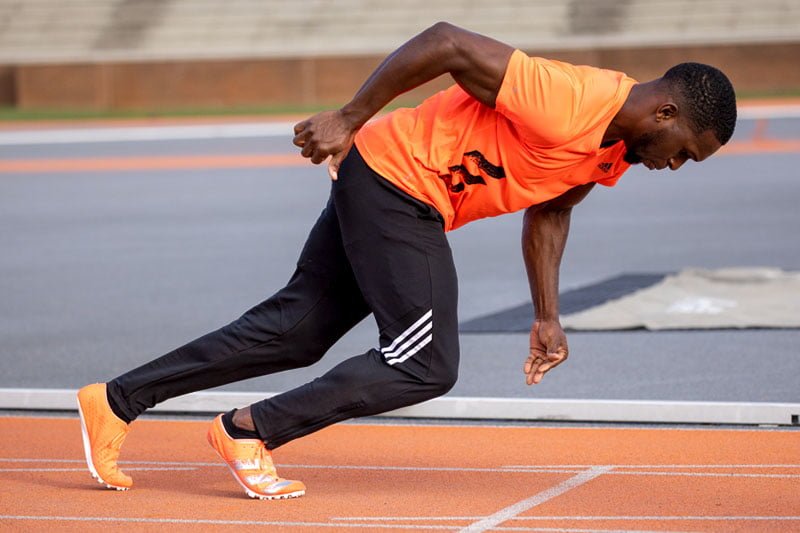
Sample Hurdle Warm Up
The hurdling warm up should include a focus on hurdling mechanics before adding the intensity of hurdling at speed. Stationary drills that work on lead leg mechanics, focusing on driving the thigh to the chest with the knee leading, heel close to the glutes, and a dorsiflexed foot will get all the nerves and muscles ready for proper hurdling technique. Additionally, drills that reinforce the trail leg and 3-step rhythm prepare the mind for moving correctly through the hurdles. This gives the opportunity to adjust trail leg mechanics, ground contact, and rhythm before introducing speed.
- Stationary Lead Leg Drill
- 4-Count Stationary Trail Leg
- Walking Through the Hands
- Jogging Drill from the Side

Sample High Jump, Long Jump, & Triple Jump Warm Up
The jumps warm up is where the details of the warm up should most closely mirror the movements in the jump. It should include similar focus to the sprint specific warm up with the addition of agility, body positioning, and jumping movements. This is the perfect time to make technique adjustments before moving onto higher intensity training.
- Rolling Stride Through
- Quick Leg Right Down & Back
- Approach with Resistance
- Accelerations to the Board
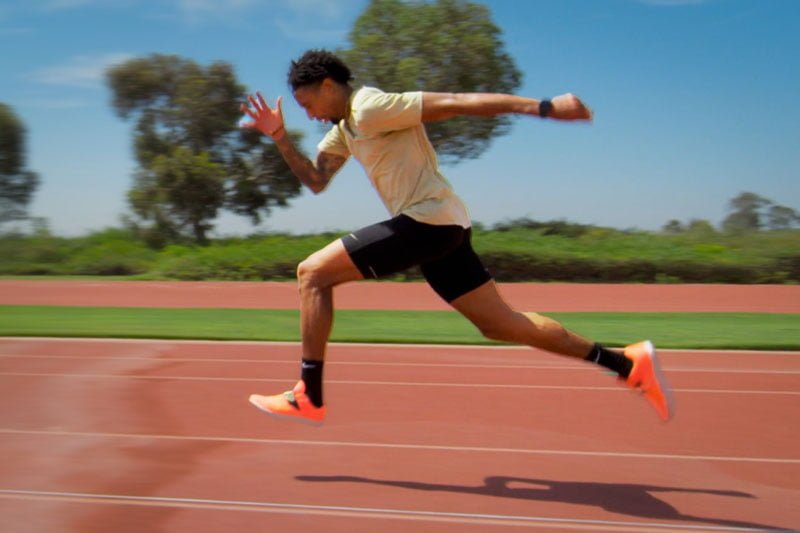
Conclusion
We’ve covered the three essential steps for a track and field warm up.
Now we’d like to hear from you.
Is your warm up sufficient? Do you plan on making any changes?
What are your go-to track and field warm up drills?
Let us know by leaving a comment below.
To learn more about maximizing your training, coaching, and performance, check out our track and field courses.


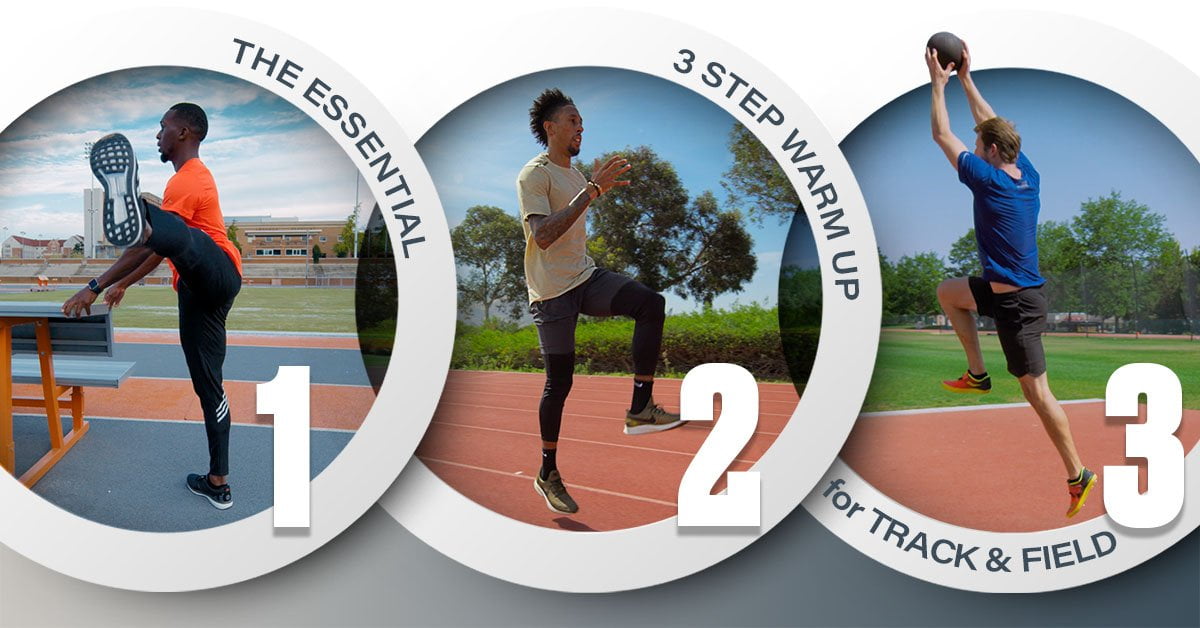
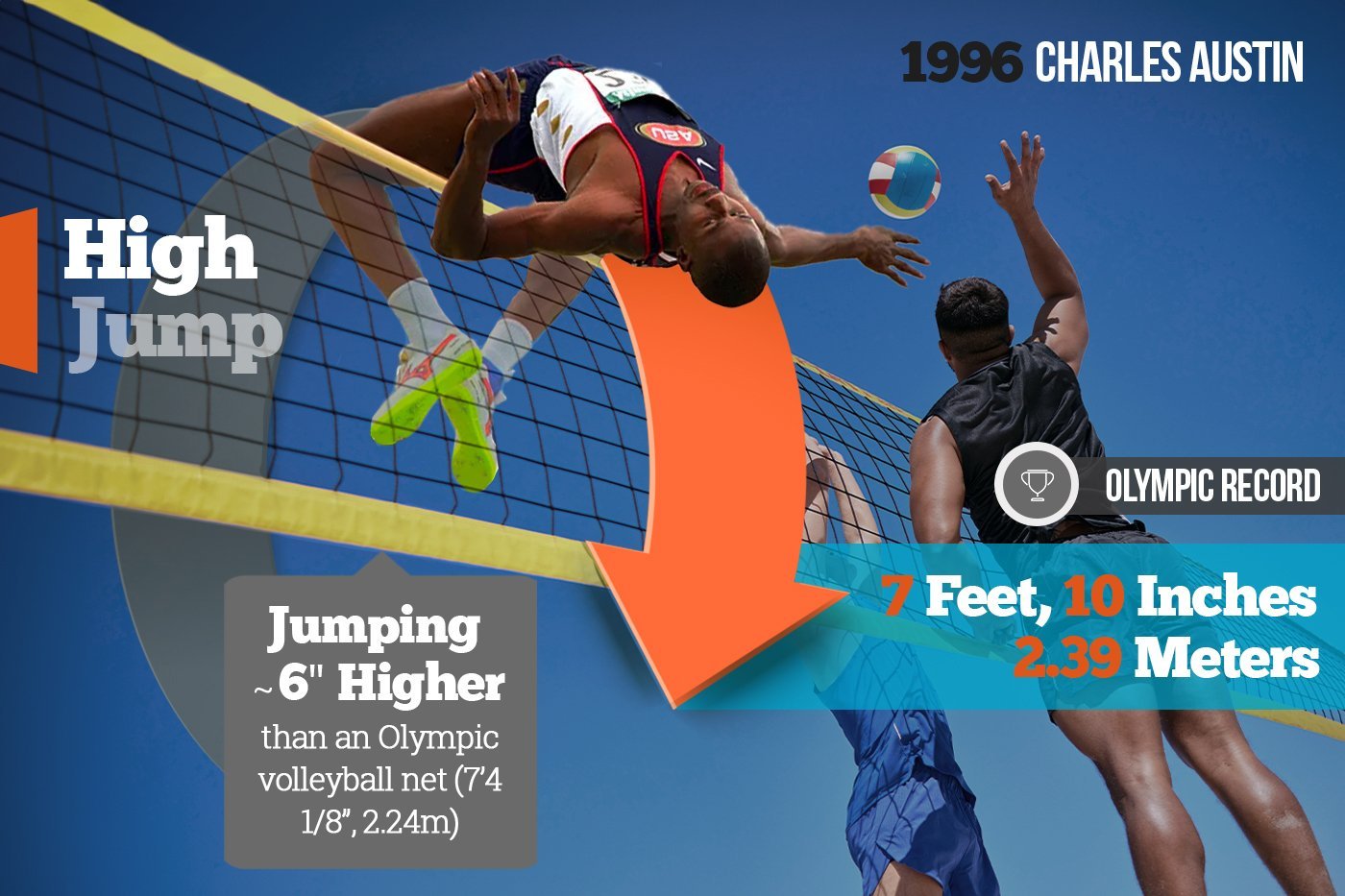
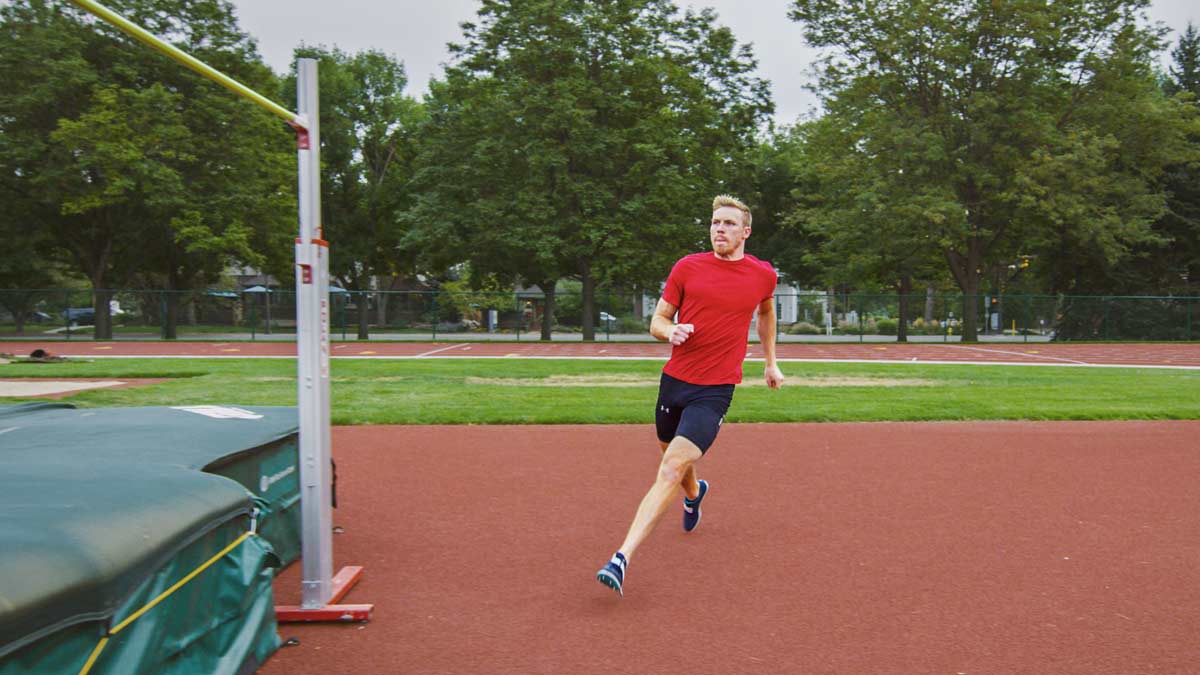
Wow! I initially started watching the YouTube short videos and then I subscribed to your channel. Great content. Very succinct and informative. I really like the demonstration videos, keep up the great work!
Thanks Chris, appreciate it!
I am a 62 year old man in good physical shape overall who is planning on transitioning from distance running to track & field. I intend to join a local track club here in Buffalo NY. Most of these stretches are new to me since I never did any of them for distance runs. My long term goal is to compete in the 2026 Gay Games in Valencia Spain. Your articles are very informative but I am unfamiliar with your almost 50 minute stretching routines. I am looking at 100m, 400m, and 1000m races to compete in. Hopefully I am not considered too old to transition to track & field. This is a new athletic venture for me.
Embarking on a transition from distance running to track and field at 62 is commendable! It's important to note that the warm-up routine described in the article is designed to be a dynamic warm-up, not just a stretching routine. This means it includes movements that are specifically aimed at preparing your body for the specific demands of track and field events, focusing on enhancing proper technique, mobility, and muscle activation.
Don't be concerned about your age; what matters is your passion and physical readiness. These warm-up exercises, though new to you, are key to a smooth transition, enhancing performance, and minimizing injury risks. Embrace the process with patience and stay committed to your training, and you'll find yourself well-prepared for your track and field journey. Good luck, and enjoy every step of this new athletic adventure!
Very informative and power pack to come across this. My sprint warm up before is nonsense. I have learned alot from you people both here and YouTube videos.
My 100m time without spike, on running shoe I have 10.50 lowest my best on is 10.12
200m 20.60
Am 23 now I stopped track 4 years ago because of lack of funds but I have been training ever since then. Am going back to track soon I feel I can do better than 4years ago. Thanks for this power you just delivered to me. Smile 😁
Thank you for your kind words Christian! It's great to hear that you found the information and videos helpful. Your 100m and 200m times are impressive. At 23, you have plenty of potential to improve and achieve your goals on the track. Keep up the hard work, and don't hesitate to reach out if you need more tips or support. Best of luck on your return to track! We're rooting for you! 😁
The content is topnotch and everything looks in place i plan on transforming my warmup routine with all of this progressively before now i will just get on track & start jogging and later do something we call type sprint before doing dynamic stretches but this approach looks more exciting to work with i look forward to updating y'all on how it affects my sprinting thank you.
Really appreciate the content created…
How much is a membership?
Thanks
Thanks so much — we really appreciate your support!
Our individual courses are priced between $90 and $120, and each course gives you lifetime access to all lessons, drills, and training materials.
If you’re looking for access to multiple courses, we also occasionally offer bundle discounts or promotions, so feel free to reach out if you’d like help finding the best option for your training goals.
Let us know if you have any other questions — we’re happy to help!
SO HELPFUL!!! I have a track meet in three weeks and I do hurdles. I was so nervous and I didn't know what to do. So I googled it and this was the first website that came up. I found the best stretches and tips for my event. I ran the hurdles this morning and I felt so ready. Those stretches really loosened up my muscles.
I couldn't be more happy with the results. I'm not as nervous as I was before because I know that I won't hurt myself. I wrote down everything you said, and I have been doing it for so long. I do them every night before I go to bed and every morning. I feel so prepared for the meet. My coach even complemented me at practice and said it looked like I was just stepping over the hurdle. I was so proud of myself. I just want to say thank you. You don't know how much you changed my self-esteem. I would get so upset over the stupid hurdle and tell myself that I was bad and I couldn't do it. But now I'm so happy and hurdles make me happy.
Wow—thank you so much for sharing this! You have no idea how much it means to hear that the article helped you feel more confident, prepared, and even excited about hurdles again. That’s exactly why we do what we do.
It’s amazing that you’ve been so consistent with your warm-ups and routines—and the fact that your coach noticed? That’s huge. You should be really proud of yourself.
Good luck at your meet in three weeks—we’re rooting for you! Keep stepping over those hurdles like a pro!